How to make a trailer for a mini-tractor with your own hands?
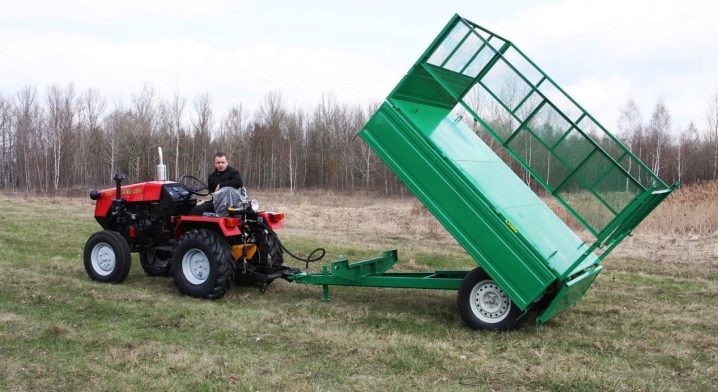
The miniature tractor has already been appreciated by many farmers. But adding factory trailers to it is very expensive for many. The way out is the independent manufacture of a device for transporting goods.
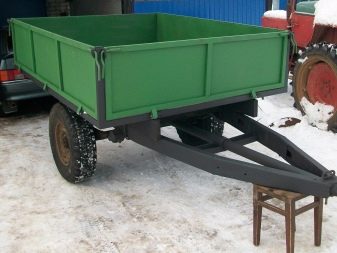

Tools and materials
In order to choose the right materials and tools for the job, you first need to determine how heavy the load on the trailer will be. Periodically bringing up several bags of fertilizer or crops is one thing, but delivering a large amount of manure or equipping a trailer with a tipper body is another matter entirely. For the manufacture of the frame, steel pipes are usually used. It will be necessary to connect tubular structures using a welding machine.
Additionally, an axle is used, on which the wheels removed from the walk-behind tractor are picked up.
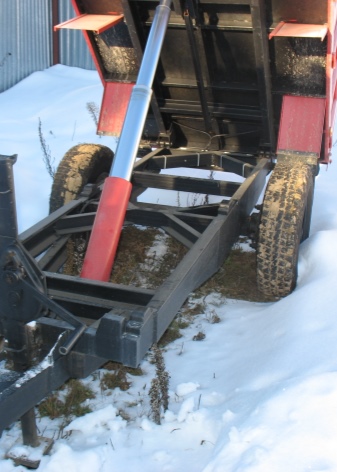

As practice shows, other wheels on trailers for mini-tractors do not work well. Two-axle trailers are more difficult to manufacture. This design will require more welding work, so you will have to prepare more electrodes of various sizes. For bodies, it is recommended to use not plastic, but metal.
Metal products are especially good if you plan to drive along forest roads, off-road and the banks of rivers or lakes. Wooden bodies of mini-tractors will definitely disappoint any hunter and fisherman. Even special coatings will not particularly increase their resistance to bad weather. The best options are definitely aluminum and thin steel sheets. Important: metal is recommended to be painted with corrosion-resistant paint.
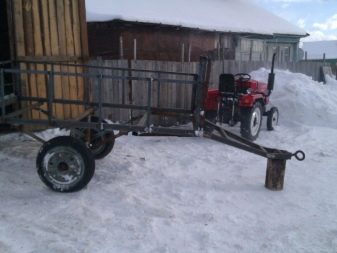

How to do it yourself?
A quality homemade mini tractor trailer should:
- be durable;
- have a relatively small mass;
- correspond in terms of carrying capacity to the tractive force of the tractor;
- have a high ground clearance;
- be equipped with wide wheel axles.
If the axles are not wide enough, it will be almost impossible to drive on a bad road. Experts advise starting the manufacture of a trailer by welding parts of the frame. It will become a supporting frame. For work, both round and rectangular pipes are used. Their minimum diameter is 400 mm.
Important: joints are made only by welding, other types of connections are not allowed.


After that, a wheelbase is created. The axis is most often a steel rod with a minimum diameter of 350 mm.
The rod must be attached to the frame using:
- side spars;
- longitudinal hinges;
- corner-type supports.
This solution allows for increased lifting capacity. It becomes possible to move not only the harvested crop, sowing material, but also the following types of cargo:
- fertilizers;
- heavy waste;
- priming;
- building materials.
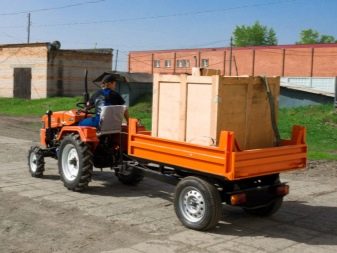
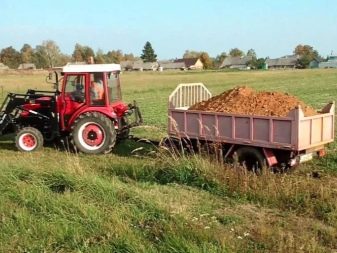
The bodies are usually made of planks. Their height is selected individually. Best of all, if the width of the boards is proportional to the height, then you do not need to divide them into parts. The wood is pre-dried. It is recommended to attach boards with steel corners, because such a connection is the most durable and stable. Place the wheels exactly in the middle. This is extremely important for driving safety. It is imperative to take care of a reliable connection with the mini-tractor itself. Experts point out that the best option is an articulated drawbar, inserted into a special tubular body.
A safety assembly is mounted on top; if not, then the connection can collapse from any push.
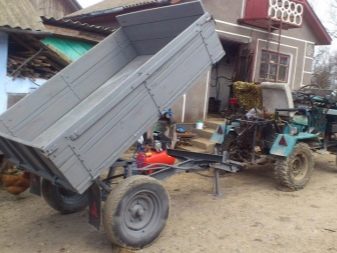
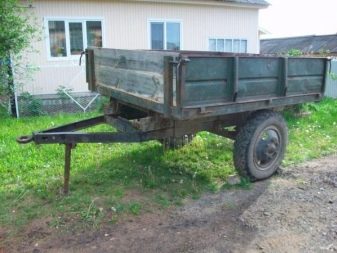
But the defense is not as simple as it seems. It is the bond between the tractor and the trailer that is subjected to very strong vibrations. And the friction force in this place is enormous. Therefore, you should not rush - both when designing and assembling. When connecting parts to each other, you need to act as carefully as possible.
Experts even advise working together. What one does not notice will almost certainly be discovered by a partner. After the end of the work, it is required to control its quality. Be sure to double-check how reliable all the nodes are, how tightly they are hinged. The bolt ties should also be checked. The assembled trailer is first run in without load, grinding the parts. As you can see, there is nothing complicated in this scheme. However, we must remember that structural elements are made only of new metal.
If old parts are used, it is only after making sure that they are free of rust and other flaws.
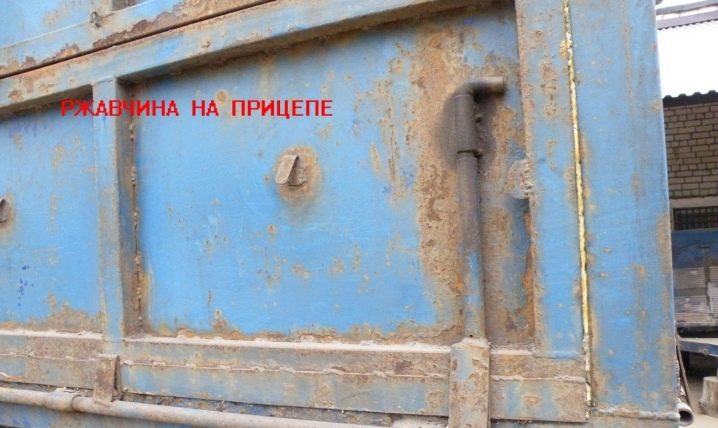
It is advisable to treat all exposed surfaces with oil paint. This is quite an affordable and, moreover, a very effective protective agent. But the simplest mini-tractor trailers do not always solve the problem. Often you have to make a tipper unit. It differs from a conventional trailer by the presence of a mechanism that raises the body as needed. Such trailers have proven themselves well when moving bulk cargo, firewood, and so on. The best lifting mechanism is driven by a hydraulic cylinder.
Studying ready-made drawings and dimensions or designing a trailer yourself, you must take into account the required carrying capacity. The number of axles directly depends on it. Single-axle carts always have a running gear without springs. The delivered goods can be unloaded either strictly backward, or also left and right. It already depends on what goals the farmer sets and how it is more convenient to work.
The two-axle type of the trailer is superior to the one-axle type both in the ability to maneuver and in overcoming off-road conditions.
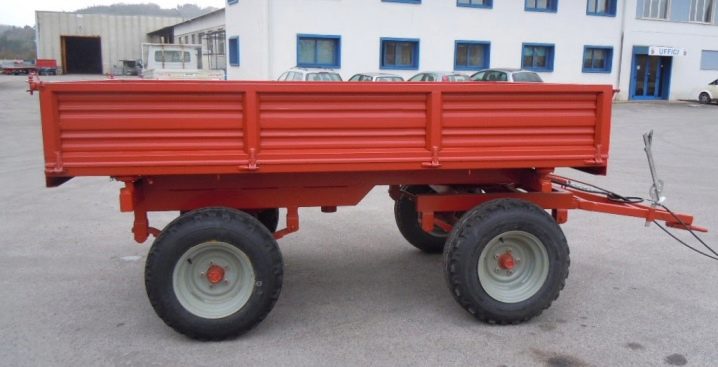
Such carts move confidently on any road. If you plan to transport a large amount of goods or move them constantly, it is advisable to give preference to the three-axle versions. It will not be possible to make such a trailer cheaply, but its increased service life will justify all investments. The main thing is that the tractor has enough power to pull such a trailer with a load.

Not all farmers and other owners need tipper trailers. They will be in demand mainly for the transportation of such goods:
- sand;
- scrap metal;
- soil;
- harvested firewood;
- clay;
- cement;
- root vegetables and other vegetables;
- grain crops;
- seed material;
- other bulky and shock-resistant loads.
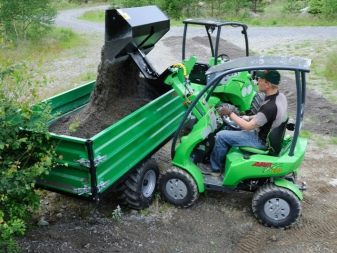
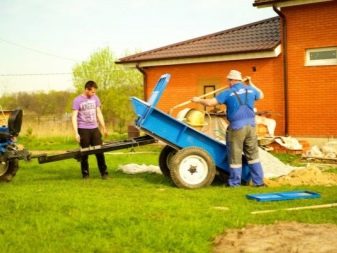
The so-called side models are equipped with drop sides. Such carts are good when you need to transport bricks and tiles, other products that require careful handling. Barrel trolleys are needed to transport not only barrels, but also boxes, containers, bags, and other containers. It is recommended to count on a trailer with a lifting capacity of 500-2000 kg. If it is less, then the device may be impractical, if it is more, the mini-tractor may not "pull" the cart.
When designing and assembling a trailer, the following design features are also taken into account:
- type of brakes (best pneumatics);
- critical angles of inclination;
- clearance.
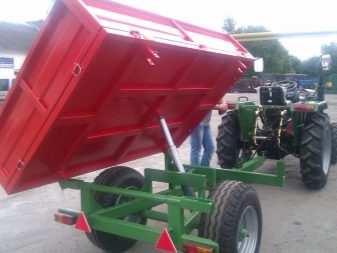

The simplest scheme is a single-axle bogie equipped with a pair of wheels, but devoid of overturning mechanisms. It is on such a device that inexperienced home craftsmen can "get their hands on". But all the same, however, drawings are needed. They show the dimensions of all parts, the size of the sections, and so on. It is advisable to use tires with rough treads.
When you already have experience, you can take on a two-axle tipper structure.
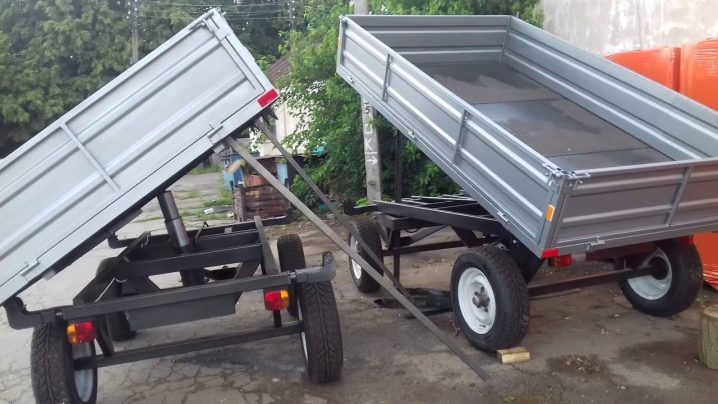
Such a cart can be easily hooked up to powerful tractor units.The product must be 3 m long and 2 m wide. The front beam is removed from the Moskvich car, and the rods are taken from old motorcycle sidecars. The drawbar can be converted from a gimbal; in addition, a damping vibration and jerking device is prepared when driving on a hinged beam.
The self-dumping (linkage) device of the tipper trailer is made by welding on the fastening loops. These hinges will help keep the body on the axle. Lifting will be done with an ordinary handle. But it must be equipped with a stopper in order to exclude spontaneous operation. There is also a lifting option, but this requires the use of an oil pump or hydraulic jack.
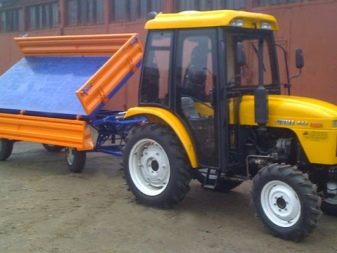
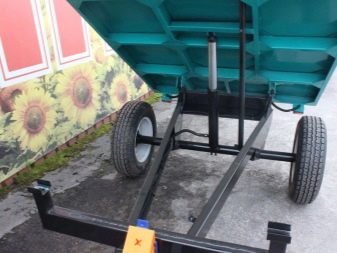
Safety engineering
Regardless of the design features, the mini-tractor trailer requires careful handling. First of all, you cannot use a trolley with an overload, as well as transport easily moving loads on it in an unsecured position. Before each road trip and upon returning, it is necessary to check the serviceability of the trailer itself and its coupling. Having found a malfunction, you should immediately eliminate it, and only then reuse the trailed cart. Be sure to remove all roughness, metal burrs.
Sharp and cutting edges are ground or otherwise removed.
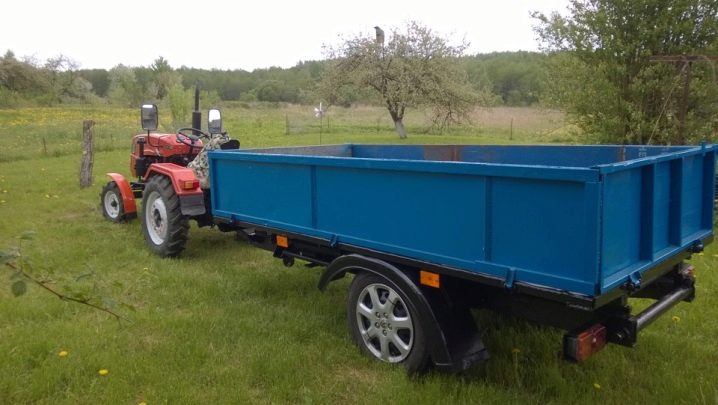
It is strictly forbidden to ride in a trailer and carry pets in it. After stopping the vehicle, even for the shortest possible time, put it on the handbrake. The steepness limits must be strictly observed. When working on a slope, they drive at the minimum speed.
You should also limit your speed when driving on a bad road, with poor visibility (night, fog, rain), before turns that are not visible visually. If the trailer is equipped with a hydraulic system, it is necessary to check every time that it does not leak. For driving in the dark and in poor visibility, you can only use carts equipped with reliable lamps of dimensions. Before leaving, they will certainly test the braking system, measure the tire pressure and the tightening of the nuts on each wheel. It is required to check the correct placement of the clamps on the platform more often.
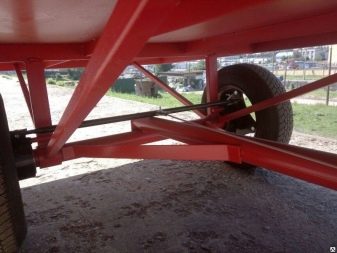
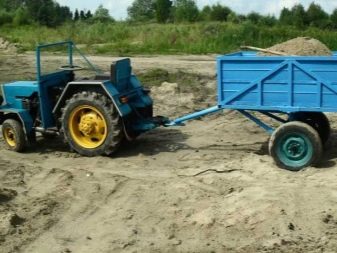
When the trolley has traveled 500 km, all connections must be checked and, if necessary, tightened. Whenever possible, load the trailer as evenly as possible. Driving on public roads is strictly prohibited. When driving, you should constantly monitor the appearance of people, animals and fixed obstacles in the immediate vicinity of the mini-tractor.
The trailer can be repaired and adjusted, other work can only be carried out in overalls and protective gloves.
For an overview of the trailer for a mini-tractor with your own hands, see the video below.



































































The comment was sent successfully.